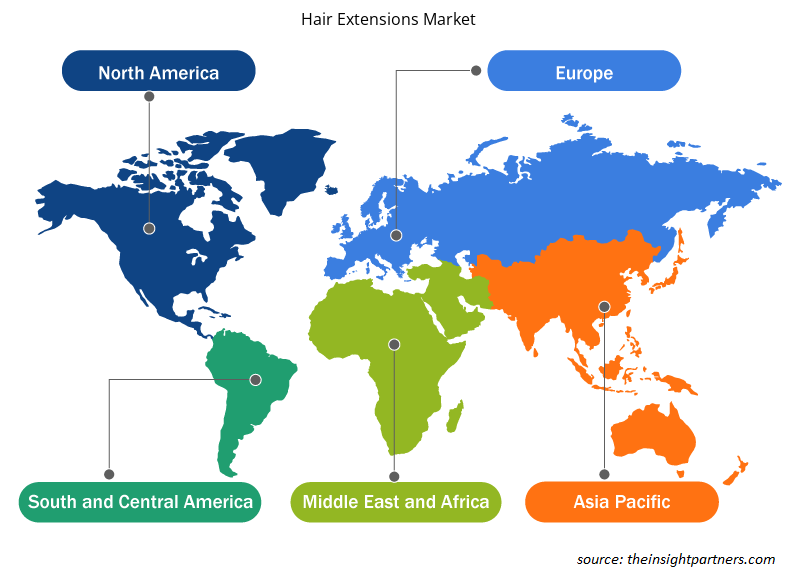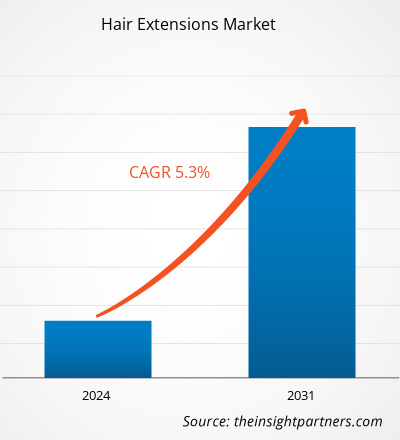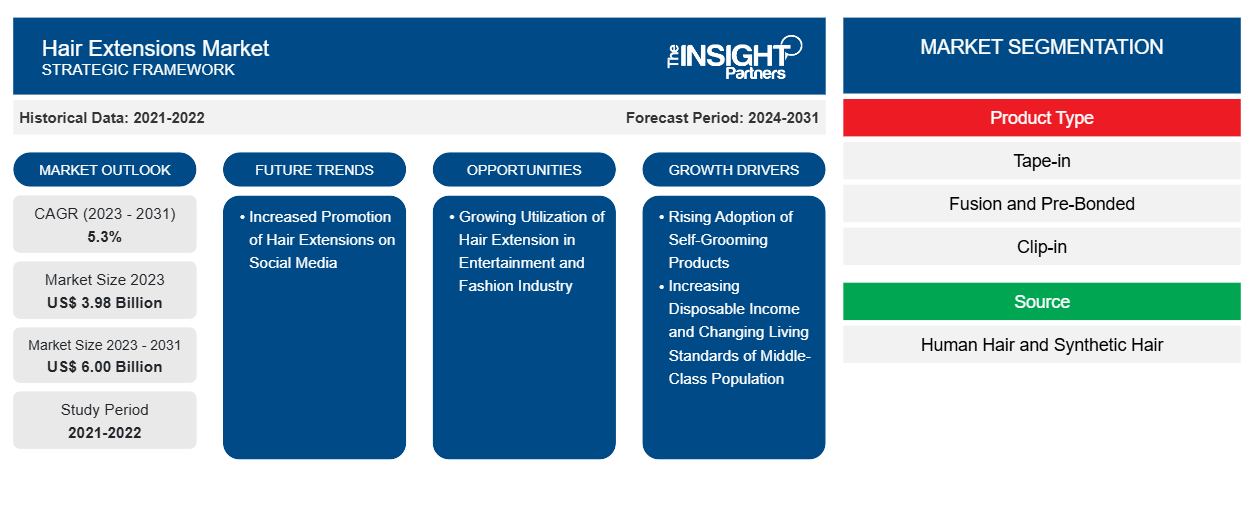Se prevé que el tamaño del mercado de extensiones de cabello alcance los 6.000 millones de dólares estadounidenses en 2031, frente a los 3.980 millones de dólares estadounidenses en 2023. Se espera que el mercado registre una CAGR del 5,3 % durante el período 2023-2031. Es probable que la creciente promoción de extensiones de cabello en plataformas de redes sociales con instalaciones de compra integradas y patrocinios de marcas en Instagram, Facebook y YouTube sigan siendo tendencias clave en el mercado de extensiones de cabello.
Análisis del mercado de extensiones de cabello
El cambio gradual de los consumidores hacia productos de cuidado personal de lujo y de primera calidad, los efectos positivos del cuidado personal en la autoestima y la interacción social, la mejora de la calidad de vida y la creciente incidencia de la caída del cabello impulsan el crecimiento del mercado de las extensiones de cabello. Se prevé que la creciente demanda de extensiones de cabello en las industrias de la moda y el entretenimiento debido a la creciente preferencia por las extensiones de cabello entre modelos y celebridades abra oportunidades potenciales para el mercado en los próximos años.
Descripción general del mercado de extensiones de cabello
Las extensiones de cabello están hechas principalmente de cabello humano o sintético de diferentes longitudes, volúmenes y colores. Se pueden personalizar para adaptarse a los requisitos de los clientes y un peluquero puede peinarlas. Al sujetar las extensiones de cabello, no se altera la textura original del cabello. Estas ofrecen una solución rápida para agregar volumen y hacer que el cabello luzca más largo y abundante sin la necesidad de someterse a un doloroso procedimiento de trasplante de cabello. Por lo tanto, con el aumento de los ingresos disponibles y la mejora de los niveles de vida, junto con el auge del sector minorista de la moda, se espera que el mercado de las extensiones de cabello continúe floreciendo en los próximos años.
Personalice este informe según sus necesidades
Obtendrá personalización en cualquier informe, sin cargo, incluidas partes de este informe o análisis a nivel de país, paquete de datos de Excel, así como también grandes ofertas y descuentos para empresas emergentes y universidades.
-
Obtenga las principales tendencias clave del mercado de este informe.Esta muestra GRATUITA incluirá análisis de datos, desde tendencias del mercado hasta estimaciones y pronósticos.
Impulsores y oportunidades del mercado de extensiones de cabello
La creciente adopción de productos de cuidado personal favorece el mercado
El cambio en las preferencias de los consumidores hacia productos de cuidado personal de lujo y de primera calidad debido al aumento del ingreso disponible, el aumento del poder adquisitivo, la mejora del estilo de vida de las personas y la creciente incidencia de la caída del cabello son algunos de los factores que impulsan el crecimiento del mercado de las extensiones de cabello.
Europa y América del Norte son mercados importantes para la industria del estilismo y representan más del 60 % del mercado de cosméticos en conjunto. Los productos para el cuidado del cabello están ganando una enorme popularidad entre los consumidores debido a la creciente prevalencia del debilitamiento del cabello, la sequedad, la pérdida de volumen y otros problemas relacionados con el cabello.
Los consumidores africanos y las personas de ascendencia africana son consumidores importantes de extensiones de cabello. Los estudios revelan que las mujeres africanas están dispuestas a gastar el doble en productos de belleza y para el cabello. Por lo tanto, la creciente adopción de productos de cuidado personal entre la población mundial impulsa el mercado mundial de extensiones de cabello.
Creciente utilización de extensiones de cabello en las industrias del entretenimiento y la moda
Las extensiones de cabello son muy utilizadas en la industria del entretenimiento y la moda debido a la creciente incidencia de la alopecia. Además, la demanda de extensiones de cabello en países como los EE. UU. está determinada principalmente por las tendencias de las celebridades. Este factor influye en la población en general, y cada vez más personas demandan productos de extensiones de cabello. Recientemente, Sunny's Hair & Wigs, una tienda minorista, se ha expandido a Phoenix y Atlanta desde que comenzó en Minneapolis en 1992. Tiene una amplia base de clientes en la industria del entretenimiento.alopecia. Further, the demand for hair extensions in countries such as the US is mainly determined by celebrity trends. This factor influences the general population, and more people are demanding hair extension products. Recently, Sunny's Hair & Wigs, a retail store, has expanded to Phoenix and Atlanta since it started in Minneapolis in 1992. It has a vast client base in the entertainment industry.
Las industrias de la moda y el entretenimiento se han vuelto vitales para la venta y adopción de productos de extensiones de cabello. Las casas de producción y de moda tienen en stock numerosas extensiones de cabello para modelos y actores, ya que interpretan papeles y personajes distinguidos. El aumento de las dolencias capilares entre los consumidores también está ayudando a la industria a crecer a un ritmo uniforme. El número de personas que sufren de caída del cabello está aumentando rápidamente, por lo que varias personas están optando por las extensiones de cabello. Por lo tanto, se espera que estos factores creen oportunidades lucrativas para el crecimiento del mercado de extensiones de cabello durante el período de pronóstico.
Análisis de segmentación del informe de mercado de extensiones de cabello
Los segmentos clave que contribuyeron a la derivación del análisis del mercado de extensiones de cabello son el tipo, la fuente y el canal de distribución.
- Según el tipo, el mercado de extensiones de cabello se segmenta en extensiones con cinta, fusionadas y preadheridas, con clip, con trama y otras. El segmento de las extensiones con clip tuvo la mayor participación de mercado en 2023. Las extensiones de cabello con clip, también llamadas tramas con clip, son productos listos para usar y son las extensiones menos permanentes, ya que se pueden quitar y aplicar fácilmente cuando sea necesario. Las extensiones de cabello con clip generalmente demoran entre 5 y 15 minutos en colocarse en casa. Estas son las extensiones de cabello menos dañinas y no tienen productos químicos, presión , calor u otros métodos de instalación. Por lo tanto, los beneficios como la fácil aplicación de las extensiones de cabello con clip y un menor daño al cabello natural impulsan la demanda de extensiones de cabello con clip.pre-bonded, clip-in, weft, and others. The clip-in segment held the largest market share in 2023. Clip-in hair extensions, also called clip-in wefts, are ready to use products and are the least permanent extensions as these can be easily removed and applied whenever needed. Clip-in hair extension usually takes 5–15 minutes to apply at home. These are the least damaging hair extensions and do not have chemicals,
- Por origen, el mercado se divide en cabello humano y cabello sintético. El segmento de cabello sintético tuvo una mayor participación en el mercado en 2023. Las extensiones de cabello sintético son más baratas que las extensiones de cabello humano, lo que se prevé que impulse la demanda de extensiones de cabello sintético. Además, la disponibilidad de una amplia variedad de colores, estilos y longitudes; la necesidad de poco mantenimiento; y el menor tiempo de aplicación de las extensiones de cabello sintético impulsan su demanda.
- En términos de canales de distribución, el mercado está segmentado en supermercados e hipermercados, tiendas especializadas, venta minorista en línea y otros. El segmento de tiendas especializadas tuvo una participación significativa del mercado en 2023. Las tiendas especializadas cuentan con expertos en extensiones de cabello y ofrecen servicios personalizados. Los especialistas en extensiones de cabello en las tiendas están capacitados para evaluar las necesidades individuales, recomendar productos adecuados y brindar servicios profesionales de instalación y mantenimiento. Este nivel de experiencia infunde confianza en el cliente, lo que garantiza un mejor resultado y reduce el riesgo de daños o aplicaciones incorrectas.
Análisis de la cuota de mercado de las extensiones de cabello por geografía
El alcance geográfico del informe del mercado de extensiones de cabello se divide principalmente en cinco regiones: América del Norte, Asia Pacífico, Europa, Medio Oriente y África, y América del Sur y Central.
En 2023, América del Norte dominó el mercado de extensiones de cabello. La demanda de extensiones de cabello en América del Norte ha aumentado debido a las crecientes tendencias de moda de las celebridades y las elevadas actividades de belleza y cuidado personal. Los consumidores caucásicos suelen utilizar productos para el cabello por razones cosméticas o para crear una imagen de moda específica. Los consumidores caucásicos son principalmente de América del Norte y Europa y, por lo general, tienen ingresos más altos que los clientes de otras regiones. También prestan más atención a la calidad de sus productos para el cabello, lo que aumenta la demanda de productos de cabello humano. La creciente caída del cabello es otro factor importante que impulsa el crecimiento del mercado de extensiones de cabello. Los consumidores de América del Norte se centran principalmente en el uso de formas avanzadas de extensiones de cabello. Los fabricantes de la región están invirtiendo mucho en la investigación y el desarrollo de extensiones de cabello, lo que se espera que impulse su mercado en América del Norte. En los últimos 15 años, Cinderella Hair ha estado a la vanguardia de la innovación en extensiones de cabello preadheridas, proporcionando el cabello humano 100 % Remy con la cutícula más fina.pre-bonded hair extension innovation, providing the finest cuticle 100% Remy human hair.
Perspectivas regionales del mercado de extensiones de cabello
Los analistas de Insight Partners explicaron en detalle las tendencias y los factores regionales que influyen en el mercado de extensiones de cabello durante el período de pronóstico. Esta sección también analiza los segmentos y la geografía del mercado de extensiones de cabello en América del Norte, Europa, Asia Pacífico, Medio Oriente y África, y América del Sur y Central.

- Obtenga datos regionales específicos para el mercado de extensiones de cabello
Alcance del informe sobre el mercado de extensiones de cabello
| Atributo del informe | Detalles |
|---|---|
| Tamaño del mercado en 2023 | US$ 3.98 mil millones |
| Tamaño del mercado en 2031 | US$ 6.000 millones |
| CAGR global (2023 - 2031) | 5,3% |
| Datos históricos | 2021-2022 |
| Período de pronóstico | 2024-2031 |
| Segmentos cubiertos |
Por tipo de producto
|
| Regiones y países cubiertos |
América del norte
|
| Líderes del mercado y perfiles de empresas clave |
|
Densidad de actores del mercado de extensiones de cabello: comprensión de su impacto en la dinámica empresarial
El mercado de extensiones de cabello está creciendo rápidamente, impulsado por la creciente demanda de los usuarios finales debido a factores como la evolución de las preferencias de los consumidores, los avances tecnológicos y una mayor conciencia de los beneficios del producto. A medida que aumenta la demanda, las empresas amplían sus ofertas, innovan para satisfacer las necesidades de los consumidores y aprovechan las tendencias emergentes, lo que impulsa aún más el crecimiento del mercado.
La densidad de actores del mercado se refiere a la distribución de las empresas o firmas que operan dentro de un mercado o industria en particular. Indica cuántos competidores (actores del mercado) están presentes en un espacio de mercado determinado en relación con su tamaño o valor total de mercado.
Las principales empresas que operan en el mercado de extensiones de cabello son:
- Cerraduras y Fianzas
- Klix Hair Inc
- Producto de fácil aplicación.
- Grupo de peluquería Balmain BV
- Grandes Longitudes SpA
- Grupo de productos Evergreen Ltd.
Descargo de responsabilidad : Las empresas enumeradas anteriormente no están clasificadas en ningún orden particular.

- Obtenga una descripción general de los principales actores clave del mercado de extensiones de cabello
Noticias y desarrollos recientes del mercado de extensiones de cabello
El mercado de extensiones de cabello se evalúa mediante la recopilación de datos cualitativos y cuantitativos a partir de investigaciones primarias y secundarias, que incluyen publicaciones corporativas importantes, datos de asociaciones y bases de datos. A continuación, se enumeran algunos de los avances en el mercado de extensiones de cabello:
- Diva Divine Hair, el primer minorista premium de extensiones de cabello y pelucas de la India desde 2008, lanzó una nueva gama de productos económicos y de primera calidad, como extensiones de cabello con clip, postizos, pelucas y accesorios para el cabello. Los productos que ofrece Diva Divine están hechos de cabello humano 100% natural. La empresa reveló que sus extensiones de cabello con clip son fáciles de usar y brindan longitud y volumen al cabello al instante. También mencionó que sus postizos están disponibles en varias formas y tamaños, y que las pelucas son fáciles de aplicar y brindan un aspecto natural. (Fuente: Hindustan Times, boletín informativo, julio de 2022)
- La empresa de extensiones de cabello Bellami lanzó Bellami Professional Hair Care, la primera colección de cuidado de extensiones de cabello de calidad profesional del mundo para uso en el salón y en el hogar. (Happi, Newsletter, octubre de 2023)
Informe sobre el mercado de extensiones de cabello: cobertura y resultados
El informe “Tamaño y pronóstico del mercado de extensiones de cabello (2020-2031)” proporciona un análisis detallado del mercado que cubre las siguientes áreas:
- Tamaño del mercado de extensiones de cabello y pronóstico a nivel mundial, regional y nacional para todos los segmentos clave del mercado cubiertos bajo el alcance
- Tendencias del mercado de extensiones de cabello, así como dinámica del mercado, como impulsores, restricciones y oportunidades clave
- Análisis detallado de las cinco fuerzas de Porter y PEST y FODA
- Análisis del mercado de extensiones de cabello que cubre las tendencias clave del mercado, el marco global y regional, los principales actores, las regulaciones y los desarrollos recientes del mercado.
- Panorama de la industria y análisis de la competencia que abarca la concentración del mercado, análisis de mapas de calor, actores destacados y desarrollos recientes para el mercado de extensiones de cabello
- Perfiles detallados de empresas
- Análisis histórico (2 años), año base, pronóstico (7 años) con CAGR
- Análisis PEST y FODA
- Tamaño del mercado, valor/volumen: global, regional y nacional
- Industria y panorama competitivo
- Conjunto de datos de Excel
Informes recientes
Informes relacionados
Testimonios
Razón para comprar
- Toma de decisiones informada
- Comprensión de la dinámica del mercado
- Análisis competitivo
- Información sobre clientes
- Pronósticos del mercado
- Mitigación de riesgos
- Planificación estratégica
- Justificación de la inversión
- Identificación de mercados emergentes
- Mejora de las estrategias de marketing
- Impulso de la eficiencia operativa
- Alineación con las tendencias regulatorias























 Obtenga una muestra gratuita para - Mercado de extensiones de cabello
Obtenga una muestra gratuita para - Mercado de extensiones de cabello